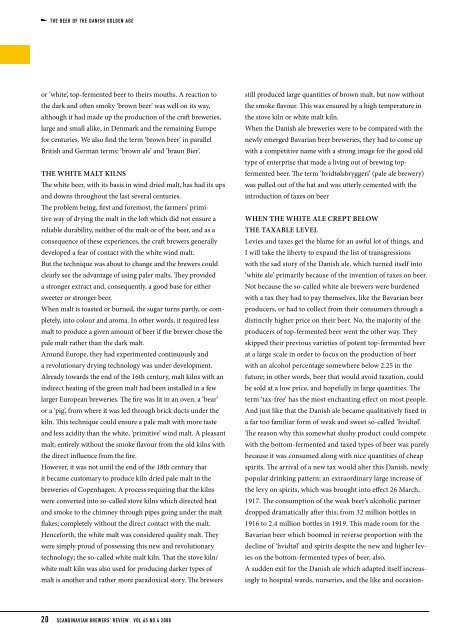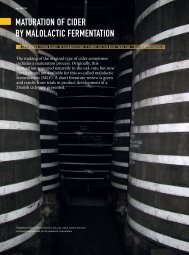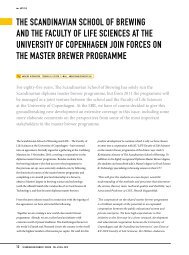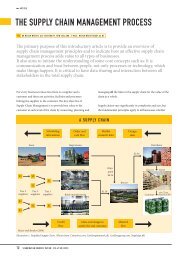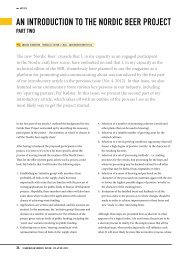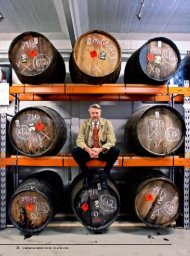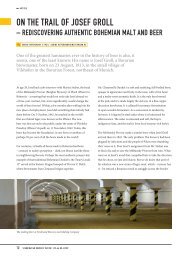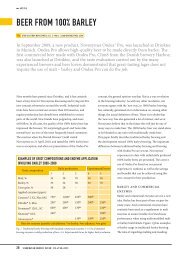The beer of The Danish GolDen aGe - Scandbrewrev.dk
The beer of The Danish GolDen aGe - Scandbrewrev.dk
The beer of The Danish GolDen aGe - Scandbrewrev.dk
Create successful ePaper yourself
Turn your PDF publications into a flip-book with our unique Google optimized e-Paper software.
<strong>The</strong> <strong>beer</strong> <strong>of</strong> <strong>The</strong> <strong>Danish</strong> <strong>GolDen</strong> <strong>aGe</strong><br />
or ‘white’, top-fermented <strong>beer</strong> to theirs mouths. A reaction to<br />
the dark and <strong>of</strong>ten smoky ‘brown <strong>beer</strong>’ was well on its way,<br />
although it had made up the production <strong>of</strong> the craft breweries,<br />
large and small alike, in Denmark and the remaining Europe<br />
for centuries. We also find the term ‘brown <strong>beer</strong>’ in parallel<br />
British and German terms: ‘brown ale’ and ‘braun Bier’.<br />
<strong>The</strong> WhiTe malT kilns<br />
<strong>The</strong> white <strong>beer</strong>, with its basis in wind dried malt, has had its ups<br />
and downs throughout the last several centuries.<br />
<strong>The</strong> problem being, first and foremost, the farmers’ primi-<br />
tive way <strong>of</strong> drying the malt in the l<strong>of</strong>t which did not ensure a<br />
reliable durability, neither <strong>of</strong> the malt or <strong>of</strong> the <strong>beer</strong>, and as a<br />
consequence <strong>of</strong> these experiences, the craft brewers generally<br />
developed a fear <strong>of</strong> contact with the white wind malt.<br />
But the technique was about to change and the brewers could<br />
clearly see the advantage <strong>of</strong> using paler malts. <strong>The</strong>y provided<br />
a stronger extract and, consequently, a good base for either<br />
sweeter or stronger <strong>beer</strong>.<br />
When malt is toasted or burned, the sugar turns partly, or com-<br />
pletely, into colour and aroma. In other words, it required less<br />
malt to produce a given amount <strong>of</strong> <strong>beer</strong> if the brewer chose the<br />
pale malt rather than the dark malt.<br />
Around Europe, they had experimented continuously and<br />
a revolutionary drying technology was under development.<br />
Already towards the end <strong>of</strong> the 16th century, malt kilns with an<br />
indirect heating <strong>of</strong> the green malt had been installed in a few<br />
larger European breweries. <strong>The</strong> fire was lit in an oven, a ‘bear’<br />
or a ‘pig’, from where it was led through brick ducts under the<br />
kiln. This technique could ensure a pale malt with more taste<br />
and less acidity than the white, ‘primitive’ wind malt. A pleasant<br />
malt; entirely without the smoke flavour from the old kilns with<br />
the direct influence from the fire.<br />
However, it was not until the end <strong>of</strong> the 18th century that<br />
it became customary to produce kiln dried pale malt in the<br />
breweries <strong>of</strong> Copenhagen. A process requiring that the kilns<br />
were converted into so-called stove kilns which directed heat<br />
and smoke to the chimney through pipes going under the malt<br />
flakes; completely without the direct contact with the malt.<br />
Henceforth, the white malt was considered quality malt. <strong>The</strong>y<br />
were simply proud <strong>of</strong> possessing this new and revolutionary<br />
technology; the so-called white malt kiln. That the stove kiln/<br />
white malt kiln was also used for producing darker types <strong>of</strong><br />
malt is another and rather more paradoxical story. <strong>The</strong> brewers<br />
20 SCANDINAVIAN BREWERS’ REVIEW . VOL.65 NO.4 2008<br />
still produced large quantities <strong>of</strong> brown malt, but now without<br />
the smoke flavour. This was ensured by a high temperature in<br />
the stove kiln or white malt kiln.<br />
When the <strong>Danish</strong> ale breweries were to be compared with the<br />
newly emerged Bavarian <strong>beer</strong> breweries, they had to come up<br />
with a competitive name with a strong image for the good old<br />
type <strong>of</strong> enterprise that made a living out <strong>of</strong> brewing top-<br />
fermented <strong>beer</strong>. <strong>The</strong> term ‘hvidtølsbryggeri’ (pale ale brewery)<br />
was pulled out <strong>of</strong> the hat and was utterly cemented with the<br />
introduction <strong>of</strong> taxes on <strong>beer</strong><br />
When <strong>The</strong> WhiTe ale crePT beloW<br />
<strong>The</strong> Taxable leVel<br />
Levies and taxes get the blame for an awful lot <strong>of</strong> things, and<br />
I will take the liberty to expand the list <strong>of</strong> transgressions<br />
with the sad story <strong>of</strong> the <strong>Danish</strong> ale, which turned itself into<br />
‘white ale’ primarily because <strong>of</strong> the invention <strong>of</strong> taxes on <strong>beer</strong>.<br />
Not because the so-called white ale brewers were burdened<br />
with a tax they had to pay themselves, like the Bavarian <strong>beer</strong><br />
producers, or had to collect from their consumers through a<br />
distinctly higher price on their <strong>beer</strong>. No, the majority <strong>of</strong> the<br />
producers <strong>of</strong> top-fermented <strong>beer</strong> went the other way. <strong>The</strong>y<br />
skipped their previous varieties <strong>of</strong> potent top-fermented <strong>beer</strong><br />
at a large scale in order to focus on the production <strong>of</strong> <strong>beer</strong><br />
with an alcohol percentage somewhere below 2.25 in the<br />
future; in other words, <strong>beer</strong> that would avoid taxation, could<br />
be sold at a low price, and hopefully in large quantities. <strong>The</strong><br />
term ‘tax-free’ has the most enchanting effect on most people.<br />
And just like that the <strong>Danish</strong> ale became qualitatively fixed in<br />
a far too familiar form <strong>of</strong> weak and sweet so-called ‘hvidtøl’.<br />
<strong>The</strong> reason why this somewhat slushy product could compete<br />
with the bottom-fermented and taxed types <strong>of</strong> <strong>beer</strong> was purely<br />
because it was consumed along with nice quantities <strong>of</strong> cheap<br />
spirits. <strong>The</strong> arrival <strong>of</strong> a new tax would alter this <strong>Danish</strong>, newly<br />
popular drinking pattern: an extraordinary large increase <strong>of</strong><br />
the levy on spirits, which was brought into effect 26 March,<br />
1917. <strong>The</strong> consumption <strong>of</strong> the weak <strong>beer</strong>’s alcoholic partner<br />
dropped dramatically after this; from 32 million bottles in<br />
1916 to 2.4 million bottles in 1919. This made room for the<br />
Bavarian <strong>beer</strong> which boomed in reverse proportion with the<br />
decline <strong>of</strong> ‘hvidtøl’ and spirits despite the new and higher lev-<br />
ies on the bottom-fermented types <strong>of</strong> <strong>beer</strong>, also.<br />
A sudden exit for the <strong>Danish</strong> ale which adapted itself increas-<br />
ingly to hospital wards, nurseries, and the like and occasion-


